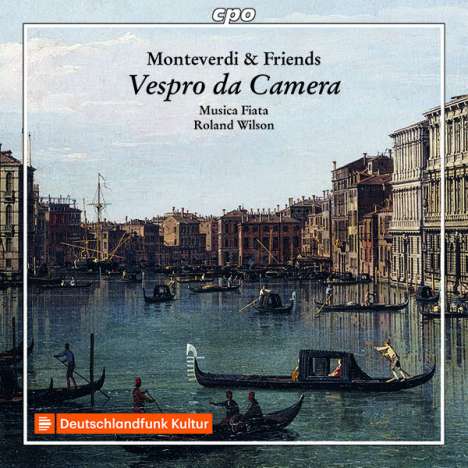Vespro da Camera - Monteverdi and Friends auf CD
Vespro da Camera - Monteverdi and Friends
Herkömmliche CD, die mit allen CD-Playern und Computerlaufwerken, aber auch mit den meisten SACD- oder Multiplayern abspielbar ist.
Marini: Domine ad adiuvandum
+Rovetta: Dixit Dominus; Beatus Vir; Magnificat; Litaniae della beatae Vergine
+Castello: Sonaten III, VIII, IX
+Monteverdi: Confitebor tibi, Domine; Laudate Dominum; Iste Confessor
+Grandi: Exaudi me Domine
+Rigatti: Laudate pueri; Ave Regina
- Künstler:
- Marie Luise Werneburg, Alexander Schneider, Johannes Gaubitz, Dominik Wörner, La Capella Ducale, Musica Fiata, Roland Wilson
- Label:
- CPO
- Aufnahmejahr ca.:
- 2019
- Artikelnummer:
- 9735503
- UPC/EAN:
- 0761203531721
- Erscheinungstermin:
- 19.8.2021
Monteverdi & Friends
Bis vor kurzer Zeit war die Welt der klassischen Musik von großen Namen und großen Orten besessen. Natürlich besteht kein Zweifel daran, dass Claudio Monteverdi ein großer Komponist war und dass er für den Markusdom manch großartiges Werk geschrieben hat; doch nach langen Jahren erkennen wir jetzt allmählich, dass abseits von San Marco in Venedig ein eigenes musikalisches Universum existiert hat. Ohne Monteverdis Genie schmälern zu wollen, muss man zugeben, dass er in Venedig, wie man hier deutlich hört, Mitglied eines begabten, innovativen Komponistenkreises war, dessen Arbeit auch ihm zugutekam. So hören wir auf vorliegender Neuheit zwar geistliche Werke, u. a. seltene Psalmvertonungen, von Monteverdi selbst, aber auch von Giovanni Rovetta, Antonio Rigatti und Dario Costello. Die musikalische Sprache, die Monteverdi in seinen späteren geistlichen Werken anschlug, ist wegen ihrer Theatralik, ihren reichlichen Affekten und der Vorliebe für starke Kontraste kaum vom Stil seiner späten Madrigale und Opern zu unterscheiden. Sein Stellvertreter Giovanni Rovetta und sein Schüler Giovanni Antonio Rigatti bedienten sich derselben Sprache. Sie kombinieren die Instrumente deutlicher mit den Sängern, lassen sie bisweilen die Gesangslinien imitieren und füllen mit ihnen andernorts die Texturen der Tutti-Abschnitte aus. Die homophonen Passagen erzeugen mit ihren vier Singstimmen, ihren zwei hohen Instrumenten und dem Klang einer vollen Orgel die Illusion eines weitaus größeren Ensembles. Dreizehn Jahre, nachdem sich Monteverdi in Venedig niedergelassen hatte, erschienen Giovanni Rovettas Dixit Dominus und Magnificat (1626). Es sind die reifen Werke eines jungen Komponisten, der hier dieselbe musikalische Sprache spricht, die wir aus Monteverdis Selva morale kennen. Wäre es wohl möglich, dass Monteverdi von seinen jüngeren Kollegen ebenso beeinflusst wurde, wie er dieselben beeinflusst hat?
Product Information
Monteverdi & Friends
It was only recently that the world of classical music began to rid itself of its obsession with great names and great places. There of course can be no doubt that Claudio Monteverdi was a great composer and that he wrote many a magnificent work for St. Mark’s Cathedral. Yet, after many long years, we are now gradually coming to the realization that the Venetian musical universe was not limited to San Marco. Without wanting to diminish Monteverdi’s genius, we have to admit, as is clearly audible on this recording, that this master was a member of a gifted, innovative circle of composers whose creative production was also of benefit to him. On the present new release we hear sacred works, including rare Psalm settings, not only by Monteverdi himself but also by Giovanni Rovetta, Antonio Rigatti, and Dario Costello. The musical language employed by Monteverdi in his later sacred works displays a theatrical character, rich affections, and a predilection for strong contrasts that can hardly be distinguished from the style of his late madrigals and operas. His substitute Giovanni Rovetta and his pupil Giovanni Antonio Rigatti used the very same language. They more clearly combine the instruments with the singers, at times have them imitate the song lines, and in other places fill out the textures of the tutti segments with them. With their four vocal parts, two high instruments, and the plenum sound of the organ, the homophonic passages create the illusion of a much larger ensemble. Thirteen years after Monteverdi had settled in Venice, Giovanni Rovetta’s Dixit Dominus and Magnificat were published (1626). These are the mature works of a young composer who here speaks the same musical language known to us from Monteverdi’s Selva morale. Might it be possible that Monteverdi was influenced by his younger colleagues, just as they were influenced by him?
Rezensionen
FonoForum 01/2022: »Die Musica Fiata ist ja hinlänglich bekannt für ihre spritzigen und virtuosen Interpretationen. Hier brilliert sie nicht nur als Begleiter, sondern auch bei einigen Sonaten Dario Castellos.«Disk 1 von 1 (CD)
-
1 Biagio Marini: Domine ad adjuvandum
-
2 Giovanni Rovetta: Dixit Dominus
-
3 Dario Castello: Sonate Nr. 9 à 3
-
4 Claudio Monteverdi: Confitebor tibi Domine SV 194
-
5 Alessandro Grandi: Exaudi me Domine
-
6 Giovanni Rovetta: Beatus Vir à 5
-
7 Dario Castello: Sonate Nr. 8 à 2
-
8 Giovanni Rigatti: Laudate pueri à 5
-
9 Dario Castello: Sonate Nr. 3 für 2 Soprane
-
10 Claudio Monteverdi: Laudate Dominum SV 197a
-
11 Claudio Monteverdi: Iste Confessor SV 278b
-
12 Giovanni Rovetta: Magnificat à 6
-
13 Giovanni Rigatti: Ave Regina Caelorum
-
14 Giovanni Rovetta: Litaniae della beatae Vergine à 4
Mehr von Biagio Marini












